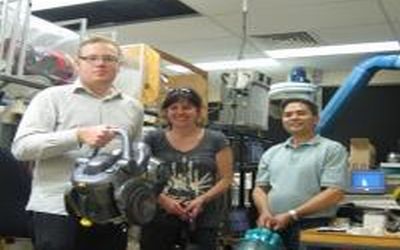Aerosolized Vacuum Dust is a Potential Disease Vector
The aerosolized dust created by vacuums contain bacteria and mold that "could lead to adverse effects in allergic people, infants, and people with compromised immunity," according to researchers at the University of Queensland and Laval University. Their findings are published ahead of print in Applied and Environmental Microbiology.


The vacuums the researchers are holding were among those that had bags and emissions assayed in the study. Other experimental equipment is in background. The researchers pictured are (L-R) Luke Knibbs, Caroline Duchaine and Congrong He.
The aerosolized dust created by vacuums contain bacteria and mold that "could lead to adverse effects in allergic people, infants, and people with compromised immunity," according to researchers at the University of Queensland and Laval University. Their findings are published ahead of print in Applied and Environmental Microbiology.
This finding is worrying as the study found resistance genes for five common antibiotics in the sampled bacteria along with the Clostridium botulinum toxin gene. This is of particular concern as, "The dust found indoors could act as a vehicle for infant botulism infection that can have severe consequences," including sudden infant death syndrome, according to previous studies.
"Even though no quantitative data are available for antibiotic resistance gene emission while vacuuming, the observed emission rates for bacteria might suggest that the genetic content of those bacterial cells, including antibiotic resistance genes, may contribute to indoor bioaerosol exposure," explain the researchers.

A vacuum is tested inside the clean air wind tunnel.
Researchers used a special clean air wind tunnel to measure vacuum emissions from 21 vacuums of varying quality and age. The clean air wind tunnel enabled them to eliminate other sources of particles and bacteria, says Luke Knibbs. "That way, we could confidently attribute the things we measured purely to the vacuum cleaner."
The results were in accord with earlier studies which have shown human skin and hair to be important sources of bacteria in floor dust and indoor airwhich can be readily resuspended and inhaled, says report co-author, Caroline Duchaine.
Knibbs hopes that other studies will follow this one, raising the profile of potential indoor sources of culprits in unsolved medical cases. The investigators conclude their report, saying that vacuum cleaners are "underrepresented in indoor aerosol and bioaerosol assessment and should be considered, especially when assessing cases of allergy, asthma, or infectious diseases without known environmental reservoirs for the pathogenic or causative microbe."
Source: American Society for Microbiology
Â
Infection Intel: Revolutionizing Ultrasound Probe Disinfection With Germitec's Chronos
November 19th 2024Learn how Germitec’s Chronos uses patented UV-C technology for high-level disinfection of ultrasound probes in 90 seconds, enhancing infection control, patient safety, and environmental sustainability.
Clean Hospitals Corner With Alexandra Peters, PhD: The Issues Around Outsourcing
November 7th 2024Outsourcing environmental hygiene in health care facilities offers cost benefits but often compromises quality. Effective oversight, training, and standards are essential for ensuring patient safety.
Strengthening Defenses: Integrating Infection Control With Antimicrobial Stewardship
October 11th 2024Use this handout to explain the basics of why infection prevention and control and antimicrobial stewardship are essential and how the 2 fields must have a unified approach to patient and staff safety